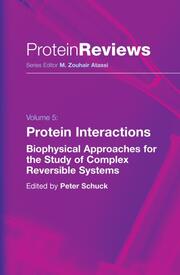Protein Interactions von Peter Schuck
Protein Interactions
Biophysical Approaches for the Study of Complex Reversible Systems, Protein Reviews 5
ISBN/EAN: 9780387359656
Sprache: Englisch
Umfang: xi, 532 S.
Einband: gebundenes Buch
Erschienen am
20.04.2007
Auf Wunschliste
When I was invited to edit this volume, I wanted to take the opportunity to assemble reviews of different biophysical methodologies for protein interactions at a level suf?ciently detailed to understand how complex systems can be studied. There are several excellent introductory texts for biophysical methodologies, many with hands-on descriptions or embedded in general introductions to physical b- chemistry. The goal of the present volume was to present state-of-the-art reviews that do not necessarily enable the reader to carry out these techniques, but to gain a deep understanding of the biophysical observables, to stimulate creative thought on how the techniques may be applied to study a particular biological system, and to foster collaboration and multidisciplinary work. Reversible protein interactions involve noncovalent chemical bonds, pro- cing protein complexes with free energies not far from the order of magnitude of the thermal energy kT. As a consequence, they can be highly dynamic and may be controlled, for example, by protein expression levels and changes in the intracel- lar or microenvironment. Reversible protein complexes may have suf?cient stab- ity to be puri?ed for study, but frequently their short lifetime essentially limits their existence to solutions of mixtures of the binding partners in which they remain populated through dissociation and reassociation processes. To understand the function of such protein complexes, it is important to study their structure and dynamics.
Dr. Peter Schuck is the acting chief of the Protein Biophysics department in the National Institute of Health's Division of Bioengineering and Physical Science. His current research work is on protein structure and function, with studies in multi-protein complexes, membrane proteins in detergent solution, self-assembling and filamenting proteins, structural and nonstructural viral proteins, homogeneous and heterogeneous interactions of immunological cell surface receptors; and biophysical methods and instrumentation through analytical ultracentrifugation, optical biosensors, static and dynamic light scattering, calorimetry, and circular dichroism.







